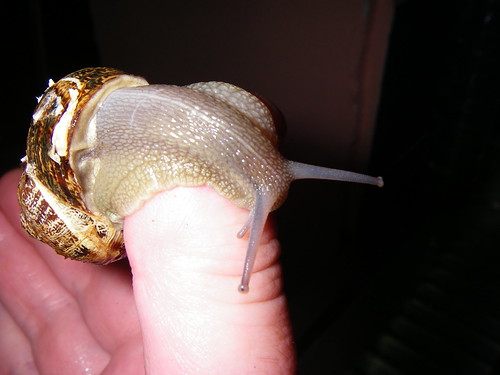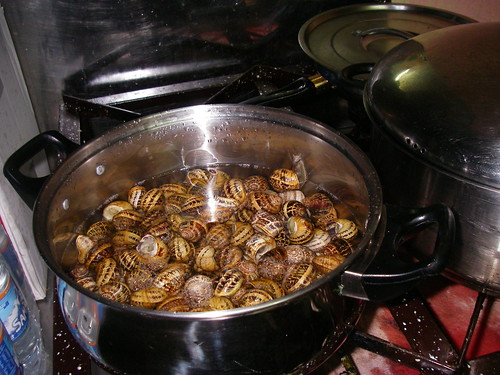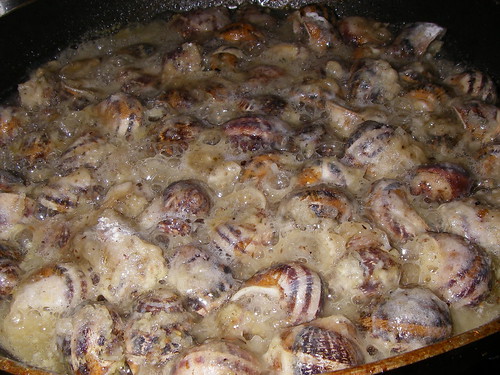Snails with Yanis
One Cretan speciality I wanted to try as soon as I spotted the main ingredients piled up in net bags in wicker baskets at the greengrocer’s were snails.
I refrained from purchasing one of those bags (about 7€ per kg.), remembering my promise about not bringing fish, fowl or other creatures into the homestay kitchenette. Besides, I didn’t have the first idea how to set about preparing the things.
None of the lower-end tavernas had snails on their menu. I wished for access to a kitchen with a friendly chef who could teach me about them.
Enter Yanis.
We had asked him whether the Cosmogonia Bar does food. To be honest, late evenings the place is plenty busy serving beer (each order is accompanied by different nibbles), and the bar is surrounded by cafés and restaurants that do. Yanis said he serves breakfast and lunchtime snacks in the season, and yes, mezedhes might be a good idea to stimulate business during early evenings. After all he did have a kitchen.
So we talked about Cretan food, and we talked about snails and Yanis said: “Why don’t I make some for you tomorrow? Come at about eleven, then you can taste them.”
And I said: “Oh, can I watch you and learn how to prepare them?”
It was early in the evening of the fateful night that almost ended in a bar fight. As predicted, the following morning my head was nearly killing me and the tension hadn’t worn off. I was in two minds about going to see Yanis, but I was damn glad that I did, even if I was a bit monosyllabic. He had been expecting me.
We spent almost the entire afternoon in the kitchen, batch-processing a kilogram of snails, with Yanis nearly forgetting about the customers who trickled into the bar every now and then.
All in the name of friendship.
Take 1 kg of snails. These were farmed. If collecting from the wild, feed on spaghetti or flour for a day or so to clean them out. Note that Roman snails (introduced—as the name implies—by the Romans into Britain for culinary use) are protected by law, whatever their original purpose. Garden snails could be used instead, if you are very patient.
If they are dormant, soak the snails in cold water for about 20 minutes to wake them up.
Remove the mucus plug with your thumb and scrape off any remnants around the rim of the shell or that’s dried onto the shell itself. Check for any dead snails and wash the survivors in fresh water.
I don’t know whether it’s true what they say about boiling a frog, but it does seem to work for snails. Transfer them into a pot and cover with water. Wait for them to settle, then put on a very slow heat. They will gradually emerge.
There is a nack to getting this just right. Doing it too quickly means that the snails retract into their shells and you’ll never get them out. Above a certain temperature, they appear to feel uncomfortable and seek to escape. Rubbing the rim of the pot with lemon juice will repel them as if they’d hit an invisible forcefield. (I never knew that snails can’t abide lemon juice.)
Surprisingly perhaps for a Mediterranean species, the snails die when the water is still cool enough to dip a finger into it. Now cover the pot and turn up the heat. Keep at a quick boil for ten minutes, skimming frequently, until almost no more foam forms.
Drain and wash the snails. Bring fresh water to the boil, replace them and add about 1 cup of vinegar and a generous sprinkling of salt.
Simmer for about 25 minutes, stirring and skimming occasionally.
At this point, it’s possible to process them further—removing them from the shell and cooking with sauce to be served with rice for instance—but one of the quickest and best ways is to fry them. Simply toss them in seasoned flour (with lots and lots or dried oregano), shell and all, and fry them in a big pan with plenty of oil, more oregano (but no garlic) and—when they’re good and sizzling—a big slug of vinegar.
As the vinegar reduces, the floury crust turns brown and sticky. Add more vinegar if desired. Total fry-time per batch is about 12 minutes. Then set the snails aside on a plate and tackle the next batch in the same pan.
How can I best describe the taste? The guey crust almost overwhelms it, but there is a certain delicate flavour to it. Yanis showed me how to eat them. The best part of the snail often remains stuck in the shell, so he cracked the very tip of it with the back of a fork, like an egg, then inserted one of the prongs and twisted it to expel the visceral goodness of the snail’s hind parts.
I made rather more a of a mess of it, which was the clue for one of his friends to pop up in the doorway. He graciously ignored me slobbering snail entrails and they talked for a while. I caught myself staring at the man. I had definitely seen him before.
“This is Kostas,” Yanis eventually said.
I shook his hand. “I—”
“You’re the one with the children!” he exclaimed. “I told Yanis, there’s no crime in Palaeochora involving children.” He laughed as if he had just told a joke, but declined the offer of some snails, about 150 of which remained on the serving dish.
I started to feel full after about five of them. What had I done? Maybe these could be served as nibble du jour to the other customers…
“Go and find John,” Yanis said, rubbing his hands. “I see you tonight. These are for you and me and Johnny.”
The day had been gloriously sunny and John stayed on the beach until the sun started to set. When he came back, he was hungry and wolved down a big plate of sausage stew. Fair enough, it was our last day in Palaeochora, we had to finish up the food, but on top of that there were 150 snails waiting for us…
We returned to the bar at around 11, as Yanis had originally suggested. It was busy and he only snatched a few brief words with us in between seeing to his duties. It was left to me to tell John about our efforts in the kitchen, just as Irini appeared with a big plate, thankfully with no more than about 1/3rd of the remaining snails on it. She declined to share. “Oh, I like them! But they’re fattening…”
Yanis, likewise, held up a hand, busy with the CD selection.
So we dug in.
John didn’t agree that the soft posterior of the snails suggested an slight flavour of scallop roe.
“They taste of the garden.”
“Oh come on, they’re nothing like African landsnails.”
“I said garden, not compost heap.”
I still maintain that they taste primarily molluscan. And as we ate our way through them, they grew on me. To be honest, cooking them can be a bit off-putting (like making Sülze), but in the end it was rewarding. I’m looking at our many garden snails with new eyes. Shame that the same method doesn’t work for slugs (eugh!)
Yanis wouldn’t let us pay anything. He had sacrificed practically an entire afternoon, as well as bought the things in the first place, and he didn’t want to take any of our money.
Tags: 'Round the World Recipes, Crete, Food, Greece, Greece, Palaeochora, Tag Index



